 Heavy Cruisers Takao, Atago, Maya, Chokai.
Heavy Cruisers Takao, Atago, Maya, Chokai.WW2 IJN Cruisers:
Furutaka class | Aoba class | Nachi class | Takao class | Mogami class | Tone classTenryu class | Kuma class | Nagara class | Sendai class | Katori class | Agano class | Oyodo
Tsushima | Asama | Tokiwa | Yakumo | Izumo | Kasuga | Hirado
The most formidable IJN heavy cruisers: The Takao heavy cruiser class (started 1927, launched 1930, completed 1932) included the Takao, Atago, Maya and Chokai. They were were among the very best and most active Japanese cruisers of the Second World War, really outshining all the others. Like the other IJN cruisers of the time, they were extensively rebuilt before 1941 operations, but less extensively than their older counterparts, the Nachi. The most striking aspect was their bulkier appearance, that some argued played in their favor for exceptional resilience. The excellence of their ASW protection was also shown by the amazing survival of IJN Takao after a triple torpedo hit.
In operations, these four apocalypse riders became the spearhead of the Imperial Japanese Navy: They participating in most major engagements of the war in the pacific as part of Admiral Kurita’s shock squadron, on Toyoda’s orders: They survived the early phase of the war and all four participated in the epic Battle of Leyte in October 1944. But on October 21st their squadron was spotted by American submarines laid in ambush. They were attacked on the evening of the 23rd by USS Darter and Dace, and IJN Atago and Maya were sunk that day. IJN Chokai was blasted by USN aviation and finished off by USN destroyers. IJN Takao survived, barely reaching Brunei and Singapore drydock for complete repairs. Takao was ultimately sunk by British Navy commandos using XE3 mini-subs in July 1945. And so was gone the last of these splendid vessel, named after mountains, like the previous Nachi class.

IJn Takao before the war colorized by Irootoko jr.
Design
Development
The Takao program was approved in 1927, as essentially improved Nachis. They shared the same hull, although significantly larger for stability and with a deeper draft. The powerplant was the same, as the hull lined and superstructures, funnels (with an upright aft one), masts, and even armament. However they were immediately recognisable to their bulky bridge superstructure, roomier, which encompassed the sdes. They were also signalled by a better protection overall, re-introducing an armored brigde (since the 1919 Tenryu) and including quadruple torpedo tubes banks (instead of triple). Despite of all this, by the way they were constructed, they achieved a lighter standard displacement than the Nachi (9,850 tons standard instead of 10,000) which was nothing short of exceptional given their capabilities. As usual, the brain behind their conception was Yuzuru Hiraga.
Like the class, they were still intended to remain within the Washington Naval Treaty tonnage limits for cruisers and their initial design even plan for 9,850 long tons standard, less than the Nachi (Myōkō), but of course they ended up overweight, in reality around 11,350 long tons. This meant that they were marked by a low freeboard, ploughing heavily in bad weather, and had notorious stability issues, aggravated by the massive, almost battleship-like tower bridge. It seems the reasons for this was in part the gross miscalculation of some components that ended much heavier than expected. We will never know for sure.
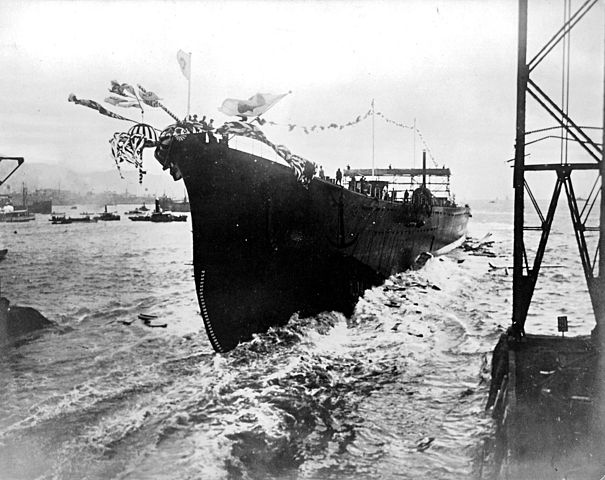
Launch of IJN Maya in 1930
Hull and Protection

ONI detailed plate (USN intel) about IJN Atago during ww2.
Essentially a repeat of the previous class, the hull had the same fine line, yet with more sloped flank to keep the same thin waterline beam, while being wider at deck level by no less than 69 cm (21 inches), allowing notably to fit quadruple TTs while keeping most of the internal arrangement of the previous vessels. Their profile was identical to the Nachi (Myōkō class) with a long sloping forward deck to the bow, a typically downward curved “ice breaker” bow, a long central flat section and another downwards curve running up to the stern, starting at the “Y” barbette. This flush deck hull, a trademark of Hiraga’s designs, saved weight. The hull measured 192.5 m (632 ft) between perpendicular and 203.76 m (668.5 ft) overall, for a beam of 19 m (62 ft) at the waterline and 20.4 m (67 ft) at deck level, and a variable draft, from 6.11 m (20.0 ft) to 6.32 m (20.7 ft).
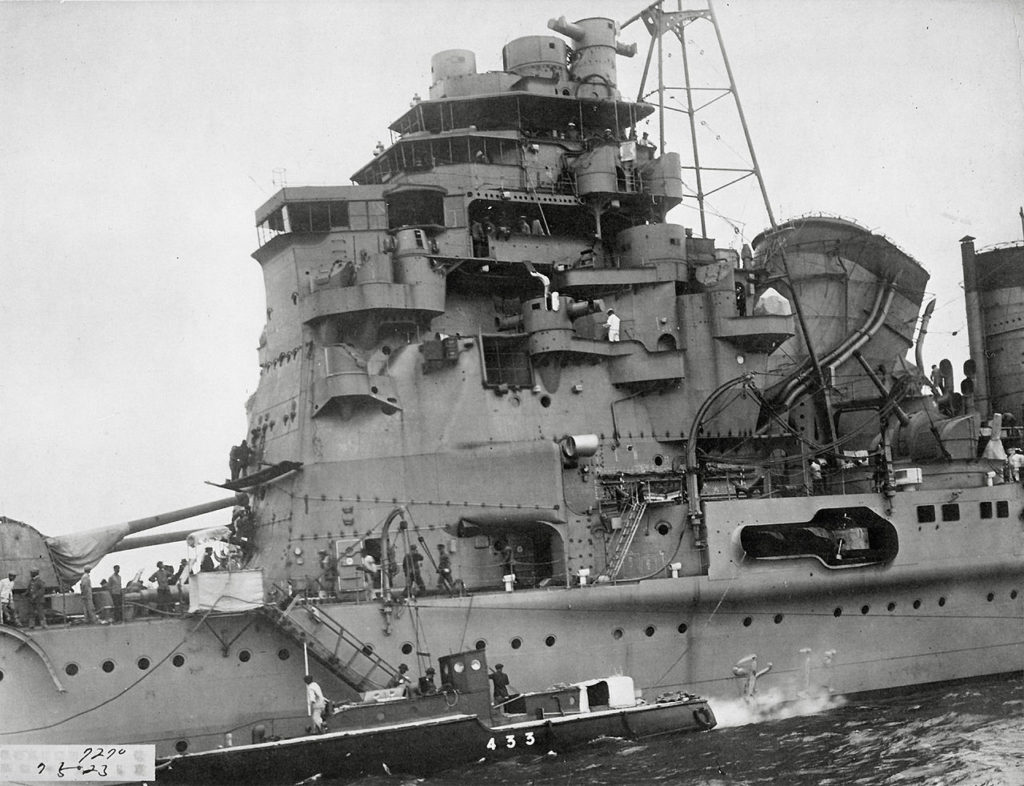
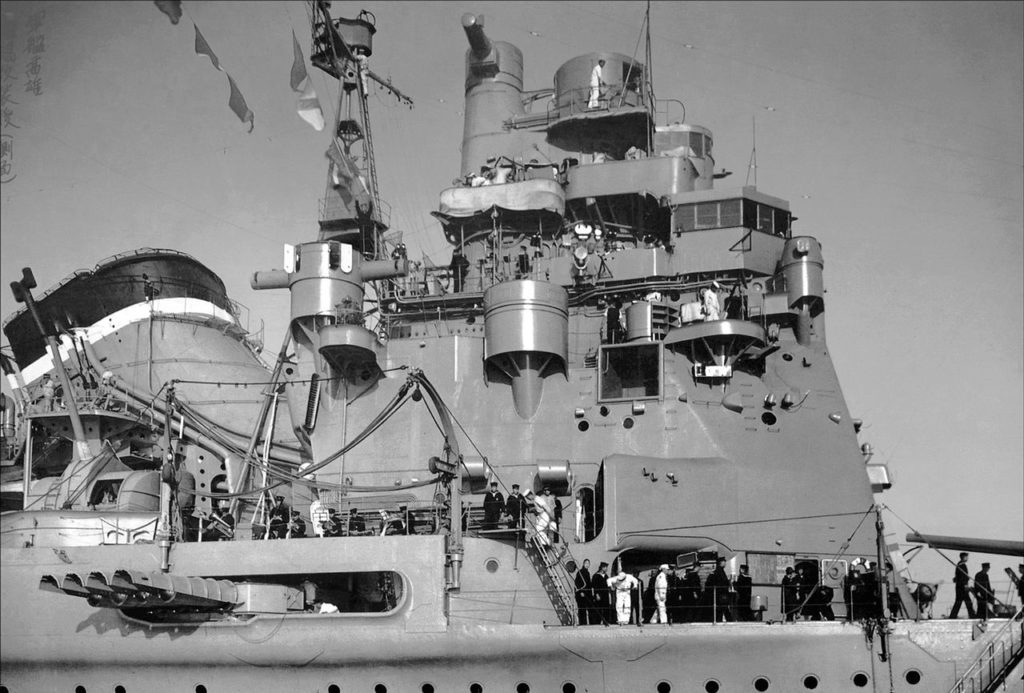
HD construction details of the cruisers. The first two shows Takao’s bridge as completed, and in 1939
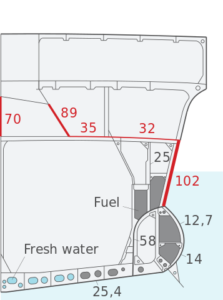 Part of the protection relied on Hiraga’s original design of integrating armor plates and structural framing to obtain a better rigidity. In a nutshell it was very comparable to the previous Nachi class: Same belt thickness 102mm at machinery level, but 127 mm (5 in) tapered down to 38 mm (1.5 in) fore and aft over the magazines. The main armored deck was thicker at 37 mm (1.45 in) versus 35 mm, and there was an upper belt ranging from 12.7 to 25 mm (0.5 – 0.98 in). Longitudinal and transverse Bulkheads were 76 to 100 mm thick, main barbettes 76 mm (3 inches) above the deck, but the turrets were essentially the same, protected by a thin 25 mm plating (0.98 in).
Part of the protection relied on Hiraga’s original design of integrating armor plates and structural framing to obtain a better rigidity. In a nutshell it was very comparable to the previous Nachi class: Same belt thickness 102mm at machinery level, but 127 mm (5 in) tapered down to 38 mm (1.5 in) fore and aft over the magazines. The main armored deck was thicker at 37 mm (1.45 in) versus 35 mm, and there was an upper belt ranging from 12.7 to 25 mm (0.5 – 0.98 in). Longitudinal and transverse Bulkheads were 76 to 100 mm thick, main barbettes 76 mm (3 inches) above the deck, but the turrets were essentially the same, protected by a thin 25 mm plating (0.98 in).
ASW protection included a three-layered defense. For once, the waist of the ship meant there was a downwards slope affecting high angle shells where the belt was 102 mm thick (4 in). Behind it were located two compartment separated by 25 mm longitudinal bulkheads, filled with oil. Below was located a bulge splitted in two sections separated by a longitudinal bulkhead, and another 58 mm thick separating it from the machinery room. The external section of the bulge ranged between 12.7 and 14 mm (0.5-0.6 in). Below this was created a double hull running for about 80% of the ship’s length, which bottom plates were 25.4 mm thick. The double hull was separated into compartments filed either by water (inward) or oil (outward).
Powerplant
It was very much the same as the previous Nachi class: Four shafts connected to geared turbine fed by 12 Kampon boilers, for a total output of 132,000 shp (98,000 kW). This was just a 2,000 shp improvement over the Nachi due to improvements in boiler pressure. Top speed was 34.2–35.5 knots (63.3–65.7 km/h; 39.4–40.9 mph) as shown on trials, comparable to the Nachi, and a range of 8,500 nautical miles (15,700 km; 9,800 mi) at 14 knots (26 km/h; 16 mph), the same as the previous cruisers. Performances would drop due to the partial reconstruction and addition of armaments made in the late 1930s and WW2.
Armament
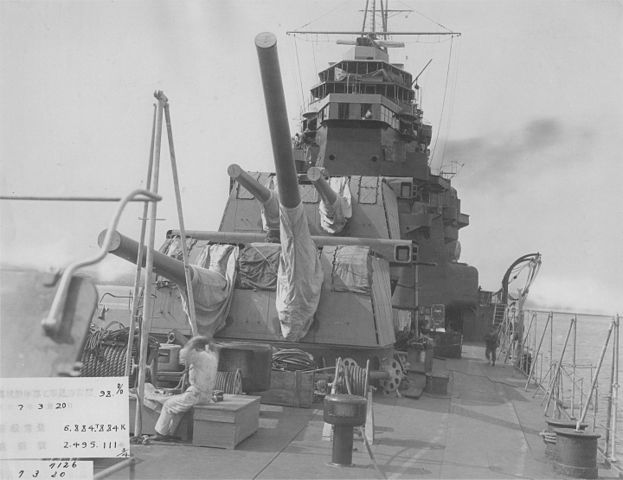
IJN Takao forward main turrets
Main armament:
Their main battery was the same as previous cruisers, ten 20.3 cm (8 in) guns, in five twin mounts. Three were placed forward (A, B, C), including one (C) facing the massive bridge and only usable in broadsides. The other two (X, Y) were placed aft of the main mast and aircraft facilities. Performances of these 20 cm/50 3rd Year Type No.2 naval guns were the same as for the Nachi.
However the Japanese Intel having knowledge of the County-class cruiser’s new high elevation mounts chooses to give their own main gun mounts extra elevation, for some anti-aircraft ability:
it was 70 degrees in the Takao, Atago, and Chōkai, and 55 degrees in the Maya. Also the elevation gear was much improved, allowing a 12°/second rate. These guns were naturally given corresponding AA shells.
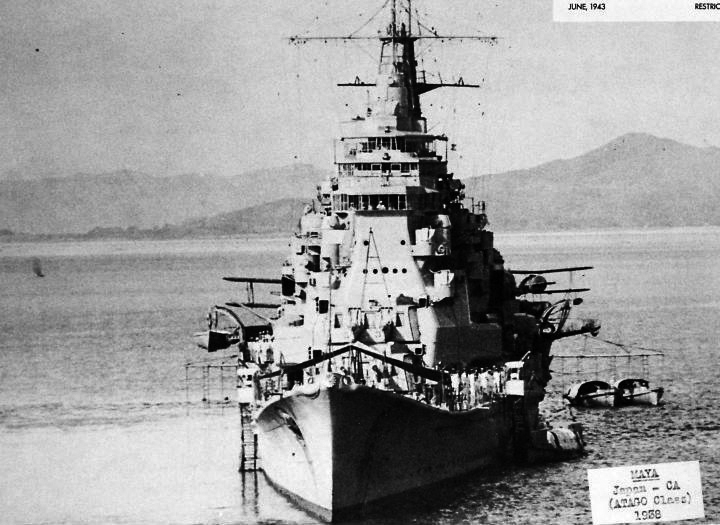
ONI, front view of IJN Maya
However in service, this proved impractical. On one side, the elevating gear was difficult to use and unreliable (prone to jamming), especially in high elevation. It was decided on the Maya and other vessels to artificially stop it at 55°, as on subsequent IJN cruisers designs. Also Switching to anti-aircraft fire control proved a longer procedure than expected, ill-adapted for fast moving targets. In fact, the guns could have only met some success against dense bomber formations flying high and detected soon enough. The other issue was related to shell lifts, as their arrangements proved inadequate. Reloading was in any case only performed at 5° elevation, significantly reducing the rate of fire. Also traverse rate was still 5° degrees per second. Last problem for the crew, the turret machinery was extremely noisy, forbidding efficient communication inside it.
Secondary armament
Like the previous Nachi, these cruisers were given the same Type 10 12 cm/45 “high-angle” anti-aircraft guns, but only four single instead of six. The missing ones were spared weight to allow the fitting of supplementary torpedo tubes. They were replaced in 1942, on the Takao and Atago, with four twin Type 89 12.7 cm/40 guns. On Maya, these were twelve (six twin) Type 89 12.7 cm/40 guns in 1943-1944 refit. IJN Chōkai kept her original, weak AA artillery until she was sunk. The Light anti-aircraft armament was weak also, limited to two Vickers “HI” Type 40 mm/62 guns and two “HI” Type 7.7mm machine guns. In 1930, given the aviation threat of the time, this was judged sufficient. Of course during refits, this armament was supplemented by Type 93 13 mm and Type 96 25 mm AA guns in large quantities.
Torpedo armament
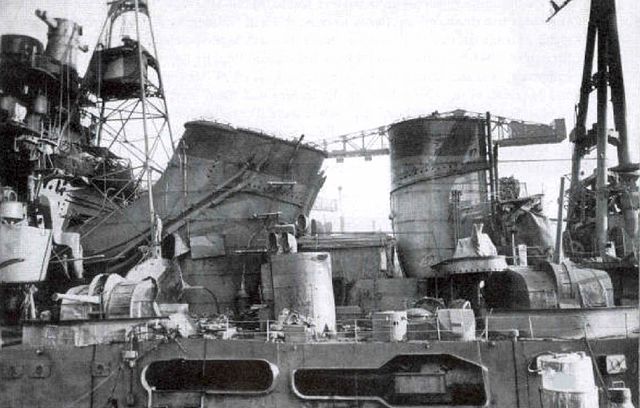
IJN Maya amidship section and TTs after battle damage in 1943
This was the cruiser’s trump card and main improvement on armament: Each cruisers carried no less than eight 24 in (61 cm) torpedo tubes, arranged in four Type 89 twin mounts. Although this was less than the Nachi (twelve), at least these could be trained on the target, contrary to the previous cruiser’s fixed ones. On addition, there were no easy reloads for the previous cruisers tubes while a rapid-reload installation was provided: There were four twin racks, one per launcher mount. In all, sixteen reload torpedoes were held in reserve, the grand total reaching twenty-four. In addition, the famous Type 91 “long lance” had no equivalent at the time in terms of speed and range. But this was just an appetizer (see the refit).
Onboard aviation
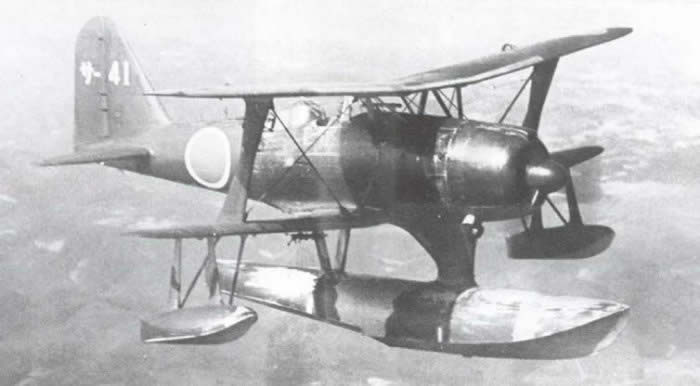
Nakajima F1M2 “Pete”
For observation, artillery spotting and reconnaissance, all four cruisers were provided with three seaplanes and two catapults on the broadside, and a hangar plus shed/workshop behind the aft funnel. They were lifted from the sea by a boom crane mated on the aft mainmast. Provision of models varied over time. At completion, they carried two E4N2, and one E7K1. During WW2, the best combination proved to be a single Aichi E13A1 “Jake” seaplane and two F1M2 “Pete” seaplanes.
Specifications (as completed)
Displacement 13,400 t. standard -14 600 t. Full Load
Dimensions 203.76 m long, 20.73 m wide, 6.11 m draft
Propulsion 4 propellers, 4 turbines, 12 boilers, 130,000 hp.
Top speed 34.2 knots
Armor from 130 (magazines) to 25 mm
Armament 10 x 203 mm (5 × 2), 8 x 127mm (4 × 2), 8 x 25 mm AA, 6 x 13.2 mm AA, 8-16 TT 610 mm (2/4 × 4), 3 aircraft
Crew 773
1938-1939 and WW2 refits
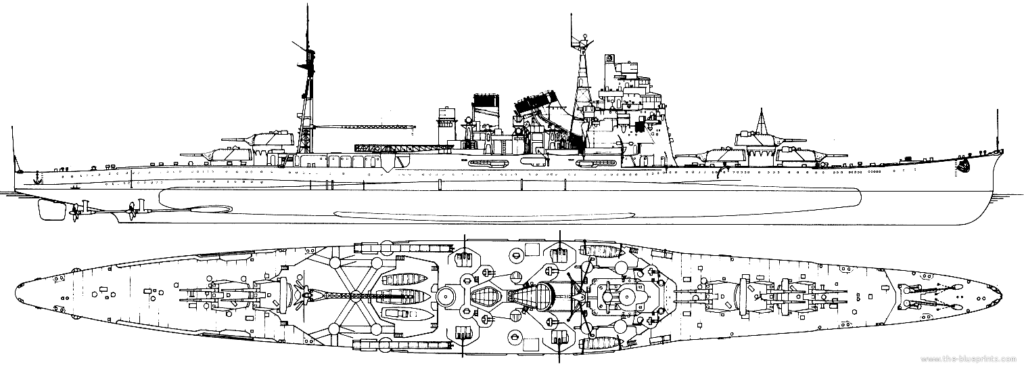
IJN Takao after reconstruction in 1939
In 1938, both IJN Takao and Atago received sixteen 24 in (61 cm) torpedo tubes, using 92 quadruple mounts, doubling its torpedo firepower. In addition, two quadruple rapid-reload racks were fitted on port and starboard. These also were modified to launch in the future the 93 torpedoes, ready and provided by 1940. IJN Chōkai and Maya had no changed made to their TTs but they were modified to launch the Type 93 torpedo as well, as provided with oxygen equipment in 1941. They also received received side ballasts bulges, while their secondary artillery was doubled for two of them and this included the addition of eight 25mm AA guns. The Chokai and Maya compensated their lack of secondary or torpedoes by seeing their AA artillery increase considerably. On the eve of the battle of Leyte, they had respectively sixty and sixty-six 25 mm AA guns.
IJN Maya received another TT refit from December 1943, obtaining sixteen 610 mm torpedo tubes, in four quadruple Type 92 mounts without reloads. She received four depht-charge racks, 2-shiki 2-go radars, new bulges for a breadth increased to 20.7 m, ASW protection down to 4.2m while her max draught rose to 6.30m. Her standard displacement went to 13,350t, top speed fell to 34.3kts, fuel stowage was decreased to 2,370t and her complement rose to 996, mostly to operate the extra AA guns.
IJN Maya at first kept her 13 mm mounts for a total of sixty-six Type 96 25 mm in thirteen triple and twenty-seven single mounts and thirty-six Type 93 13.2 mm AA guns in single mounts.
In July 1944 she would receive 18 supplementary 25mm/60 AA guns 96-shiki, and a 3-shiki 1-go radar.
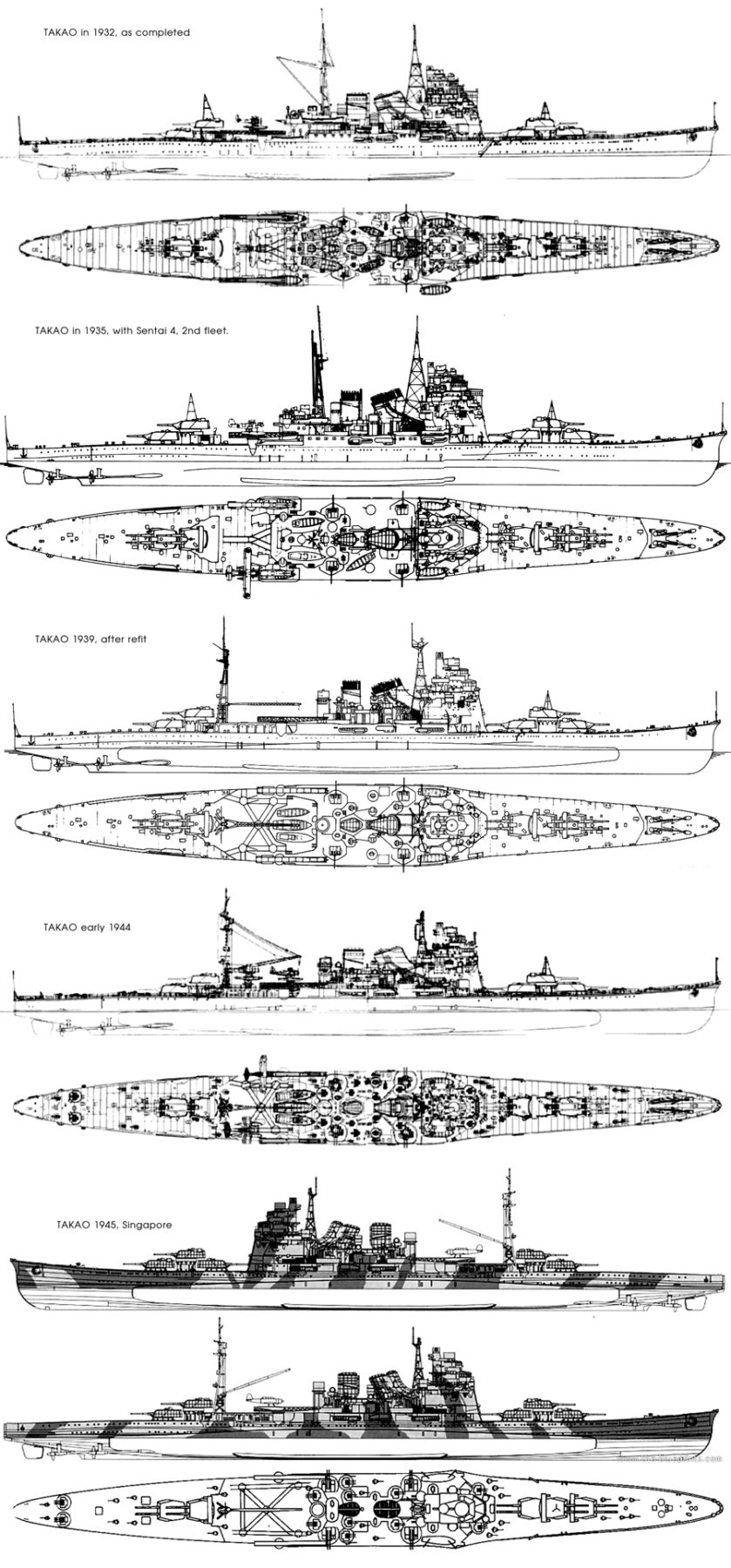
Evolution of the class, IJN Takao

IJN Maya was however partly rebuilt as an AA cruiser, sacrificing her third turret and hangar for the installation of a powerful AA combination, and quadruple TT upgrade, late 1943.
The first two (Takao, Chokai) had less AA (in twin and single mounts) and Type 93 13 mm guns instead due to their prewar refit. But later in WW2, both had sixty Type 96 25 mm (1.0 in) AA guns in thirty singe, six twin and six triple mounts. In July 1944, IJN Atago and Takao received four triple 25mm/60 AA guns, and twenty-two 25mm/60 96-shiki in single mounts, plus a new 3-shiki 1-go radar. At the same time, IJN Chokai received 12 more 25mm/60 96-shiki in single mounts and 2-shiki 2-go, 3-shiki 1-go radars.

IJN Chokai in 1938
Src/Read More & resources
Sites
//www.combinedfleet.com/takao_t.htm
//www.combinedfleet.com/atago_t.htm
//www.combinedfleet.com/maya_t.htm
//www.combinedfleet.com/chokai_t.htm
//www.navypedia.org/ships/japan/jap_cr_takao.htm
//en.wikipedia.org/wiki/Takao-class_cruiser
//admiral31.world.coocan.jp/e/stc0332.htm
//warfare.gq/dutcheastindies/kondo.html
Colorizations by Irootoko Jr

IJN Takao’s bridge in 1939
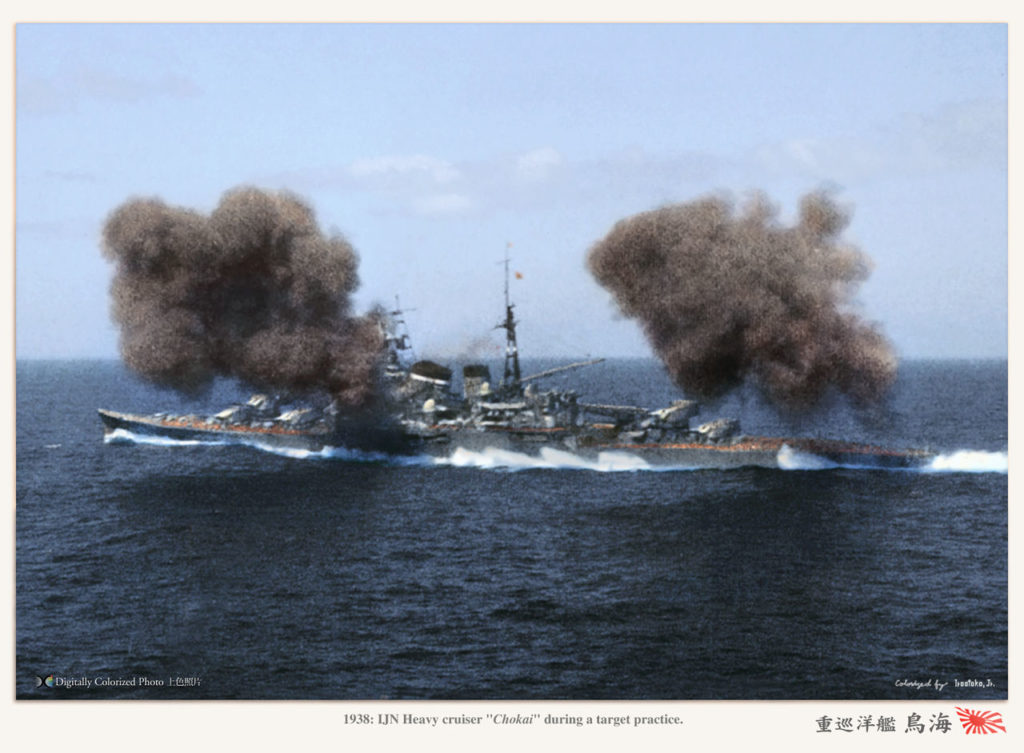
IJN Chokai in 1938 in target practice, full broadside
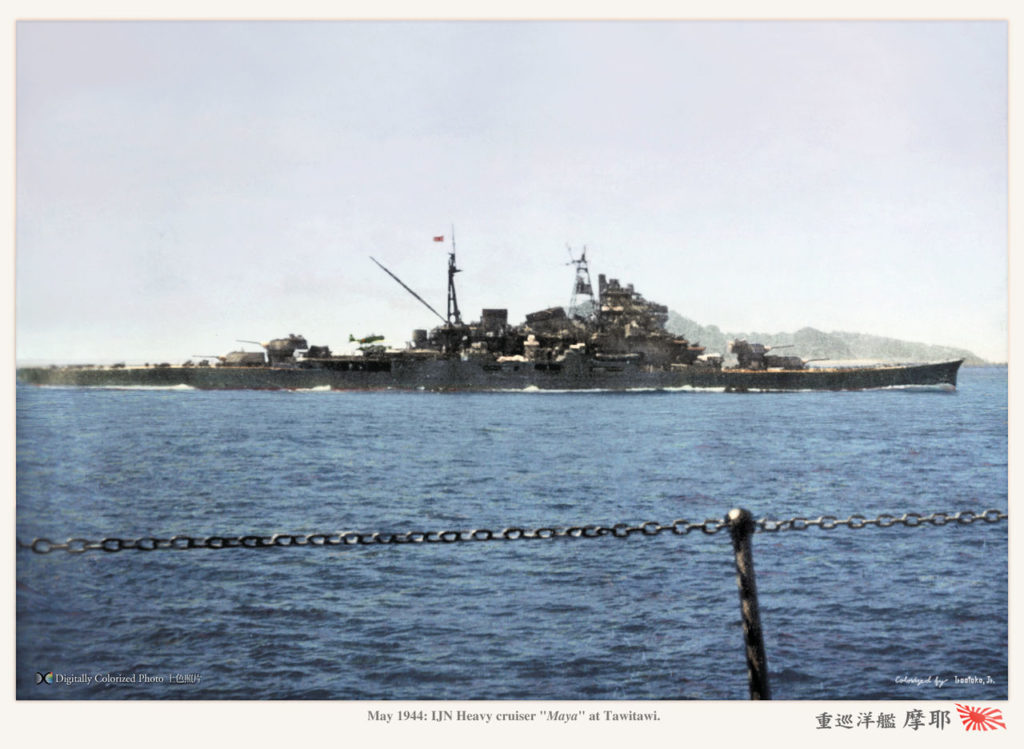
IJN Maya in 1944, Tawi Tawi atoll
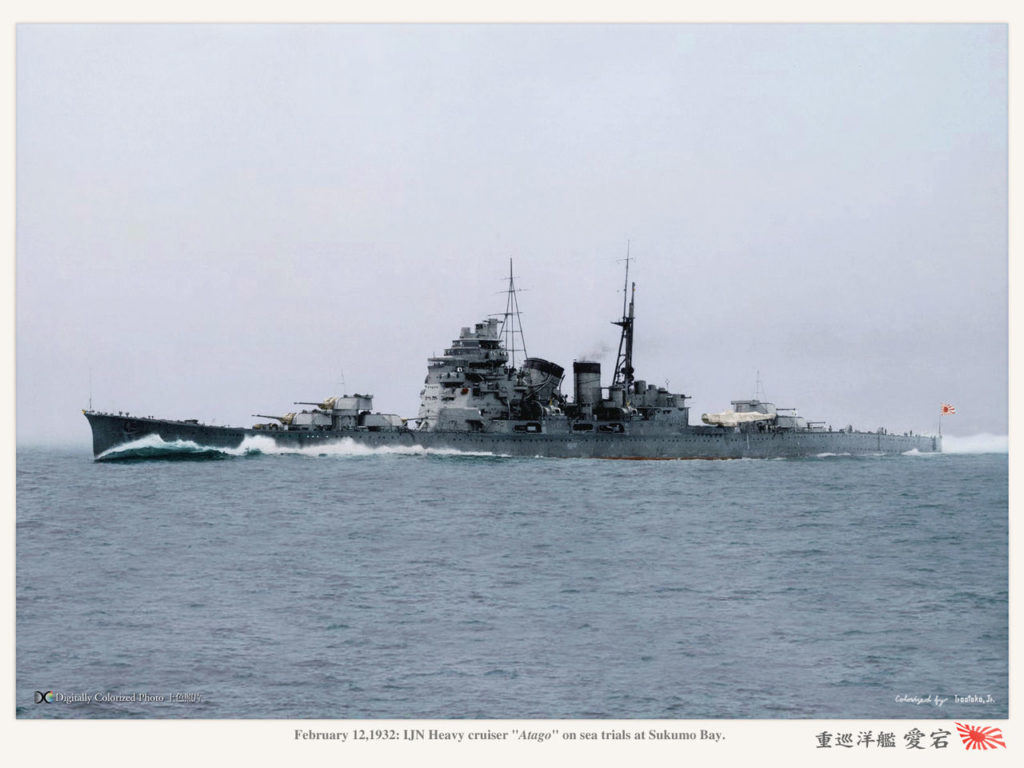
IJN Atago during her 1932 sea trials
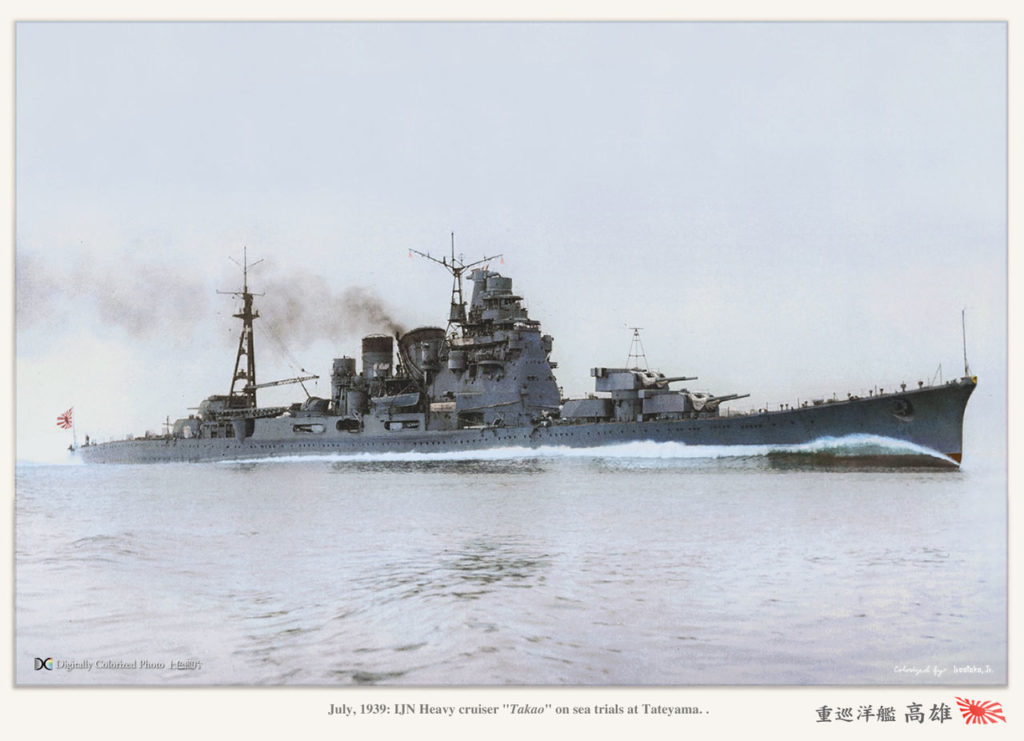
IJN Takao during her 1939 post-refit trials
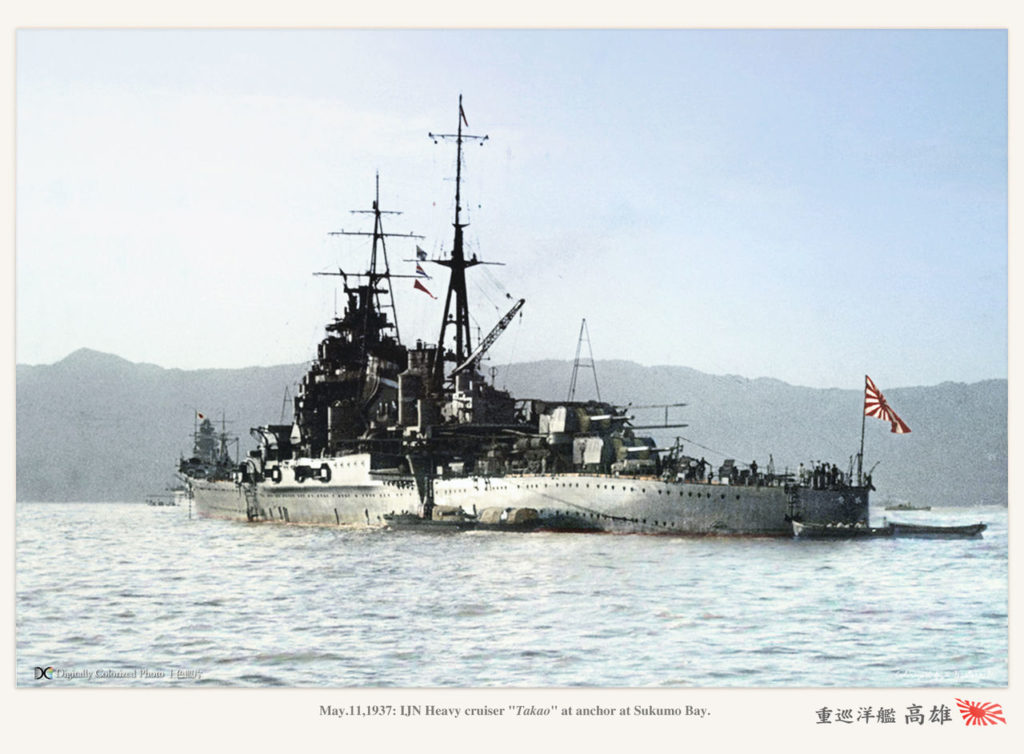
IJN Takao off China, aft view, 1937
Books:
D’Albas, Andrieu (1965). Death of a Navy: Japanese Naval Action in World War II.
Dull, Paul S. (1978). A Battle History of the Imperial Japanese Navy, 1941-1945. Naval Institute Press.
Gores, Joseph (1972). Marine Salvage. David & Charles.
Howarth, Stephen (1983). The Fighting Ships of the Rising Sun: The drama of the Imperial Japanese Navy, 1895-1945. Atheneum.
Jentsura, Hansgeorg (1976). Warships of the Imperial Japanese Navy, 1869-1945. Naval Institute Press.
Lacroix, Eric; Linton Wells (1997). Japanese Cruisers of the Pacific War. Naval Institute Press.
Patton, Wayne (2006). Japanese Heavy Cruisers in World War II. Squadron Signal Publications.
Skulski, Janusz (2004). The Heavy Cruiser Takao. Conway Maritime Press.
Watts, Anthony J. (1967). Japanese Warships of World War II. Doubleday & Company.
Whitley, M.J. (1995). Cruisers of World War Two: An International Encyclopedia. Naval Institute Press.
L, Klemen (2000). “Forgotten Campaign: The Dutch East Indies Campaign 1941–1942”.
Lundstrom, John B. (2005). First Team And the Guadalcanal Campaign: Naval Fighter Combat from August to November 1942. Naval Institute Press.
Nishida, Hiroshi. “Materials of IJN”. Imperial Japanese Navy. Archived from the original on 23 November 2016.
Parshall, Jon; Hackett, Bob; Kingsepp, Sander; Nevitt, Allyn. “HIJMS ATAGO: Tabular Record of Movement”. Combinedfleet.com.
Patton, Wayne (2006). Japanese Heavy Cruisers in World War II. Squadron Signal Publications.
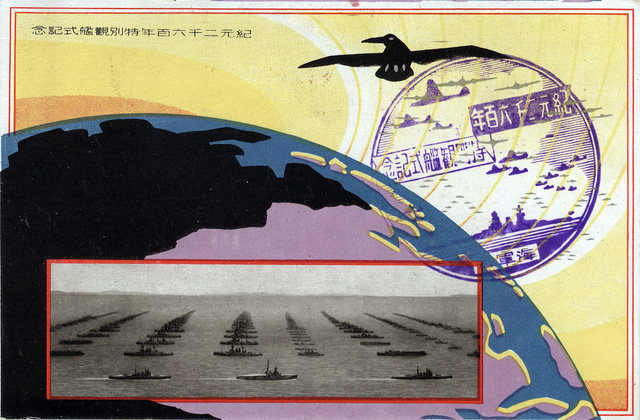
The 1940 Imperial fleet review
Model Kits

Nichimo’s rare old 1/500 kit
All has been covered by Tamiya, Hasegawa, Fujimi at least on 1:700, Marusan, Minicraft, pit-road edited a full set, Skywave (too), Aoshima 1:350, Tamiya 1:400, Nichimo 1:500, Bandai & IMAI 1:550, Eduard, Fukuya 1:350 foto-etched.
The Takao, Maya, Chokai and Atago in action
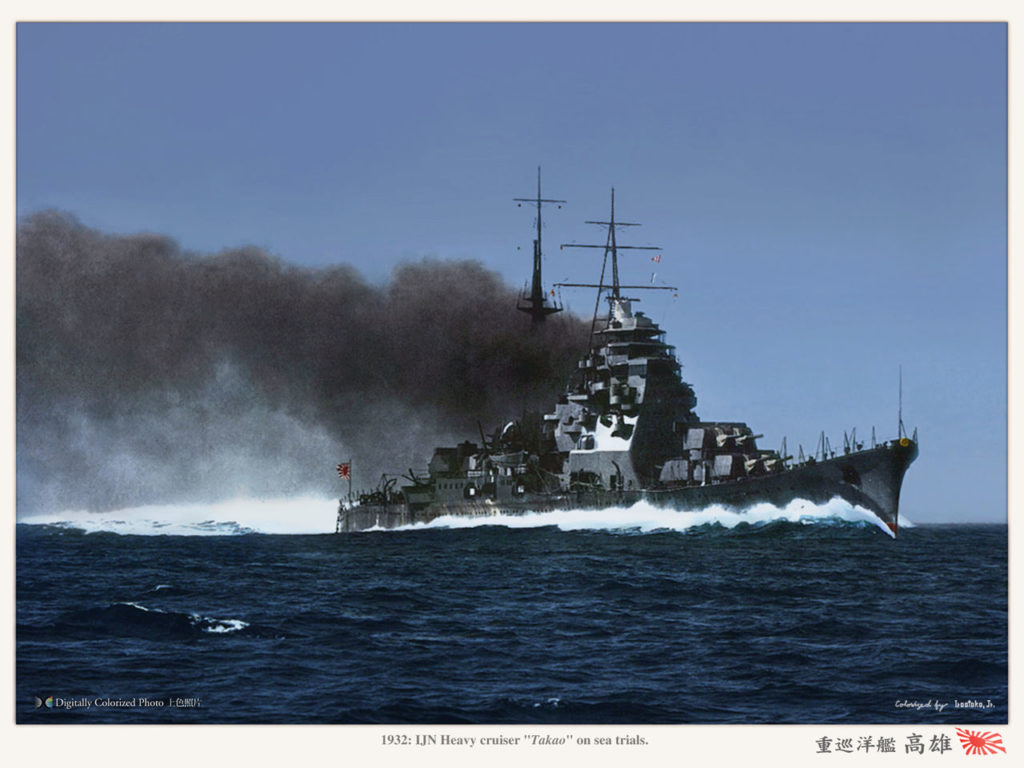
IJN Takao during her sea trials in 1932 – Colorized by Irootoko Jr. (base for the image background)
IJN Takao
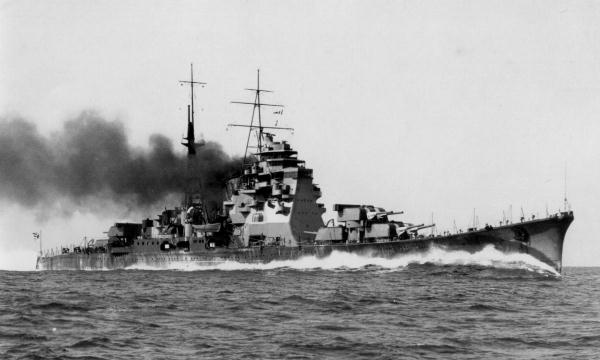
Takao on sea trials
IJN Takao was built at Yokosuka Naval Arsenal from 28 April 1927 to her launch on 12 May 1930, commissioned on 31 May 1932, two months after Atago. Yet as she was the first laid down, most historians gave the class her name. ONI plates however referred it as the “atago class”. Soon joined by her sister ships, IJN Takao was assigned to the Yokosuka Naval District. The four cruisers there formed the Sentai-4, 2nd Fleet. Under command of captain Chūichi Nagumo she trained extensively in 1933–1934 before Captain Eiji Gotō took command until 1935, followed by Captain Takeo Takagi until 1937 andTadashige Daigo until 1938 and her long refit and overhaul. Stability and seaworthiness issues were soon detected in service as she was top-heavy and both Takao and Atago were rebuilt at the Yokosuka Naval Arsenal in 1938-1939. Their bridge was lightened, the main mast relocated aft, and bulges added. Maya and Chōkai on their part only received minor modifications and stayed pretty much “in their juice” during WW2. Takao and Atago like most IJN vessels of the time patrolled off the coast of China, in 1940-1941.
Takao was not part of the escort dedicated to the attack on Pearl Harbor. Instead, under command of Captain Asakura Bunji, she was in Vice Admiral Nobutake Kondō’s Sentai-4 (all four cruisers), providing gunfire support for the landings at Lingayen Gulf (Luzon). This was the start of the Philippines campaign. In February 1942, she was off Palau, when ordered to intercept shipping escaping from the Netherlands East Indies. The hunt was good: She sank the Dutch freighter Toradja, the British minesweeper HMS Scott Harley and captured the freighter Bintoehan, on 1 March 1942. One of her floatplanes located and strafed, bombed the Dutch freighter Enggano as well. A night attack followed, during which Takao and Atago sunk the destroyer USS Pillsbury. On 4 March, Takao, Atago, Maya escorted by the destroyers Arashi and Nowaki attacked a convoy near Tjilatjap. They sank the HMAS Yarra, defending the convoy. The latter heroically made one hour and a half stand before the onslaught. The Japanese cruisers then proceeded to sink all three ships in the convoy (tanker Francol, depot ship Anking, the Minesweeper HMS 51) and captured the Dutch freighters Duymaer van Twist and Tjisaroea. The three cruisers then went back to Yokosuka for a refit, notably anti-aircraft guns. They arrived there on 18 March.
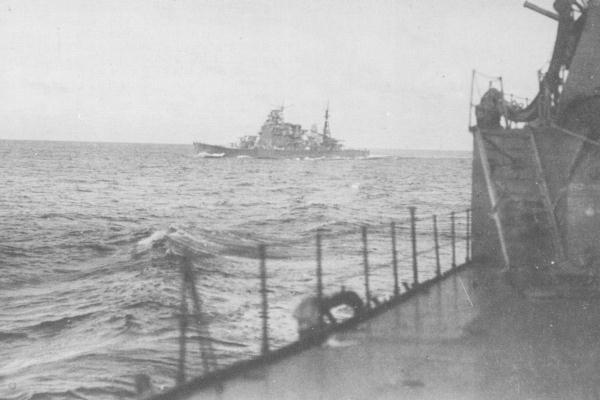
Takao seen from her sister ship, en route to the Solomons islands, 1942
In April 1942, IJN Takao was back at sea, participating in the unsuccessful pursuit of the Doolittle raid task force. On 2 May 1942, she assisted the sinking seaplane carrier IJN Mizuho, torpedoed by the USS Drum, off Omaezaki. She rescued 471 crew. In June 1942, Takao and Maya went north and brought their gunfire support during the invasion of the Aleutian Islands, and later protected the convoy bound for Kiska and the landings on Attu. On 3 June 1942, their floatplanes, deployed to detect possible threatss were attacked by USAAF Curtiss P-40 fighters from Umnak, loosing two. On 5 June IJN Takao shot down a passing by B-17 Flying Fortress and returned to Ōminato on 24 June.
In August 1942, Takao participated in “Operation Ka”: The first large reinforcement mission to Guadalcanal. She departed Hashirajima in Japan with IJN Atago and Maya, on 11 August, and headed for Truk. She was, like her sisters, involved in the Battle of the Eastern Solomons, on 24 August, but were too far to intervene. They had their chance at the Battle of the Santa Cruz Islands on 26 October however. Like her sisters and Myōkō and Haguro she took part in a legendary night combat resulting in numerous USN losses, including the aicraft carrier USS Hornet.
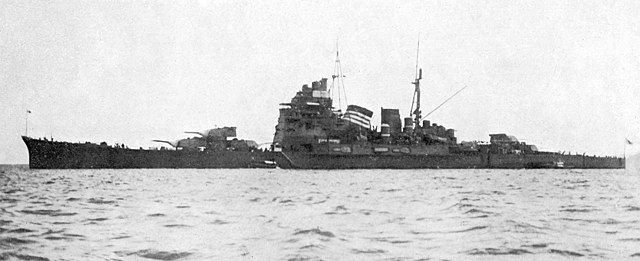
From there, another mission followed, bombarding Henderson Field. This led to the Naval Battle of Guadalcanal, on the morning of 15 November 1942. IJN Kirishima flanked by Takao and Atago, engaged USS Washington and South Dakota. This was the first naval duel between capital ships in this theater. South Dakota was taken as target by all three ships, including IJN Takao, at some point lossing all power, radar and fire controls. Takao and Atago then closed and fired their Long Lance torpedoes at USS Washington, but missed. IJN Kirishima was disabled however by a precise fire from her, and later sank. While IJN Atago was damaged, IJN Takao escaped unscaved, to Truk. From there, she departed for Kure, for repairs and a drydock overhaul in December 1942.
By early 1943, IJN Takao escorted troopships from Guadalcanal, which was evacuated. The fleet she escorted also comprised the IJN Zuikaku, Zuihō and Jun’yō, IJN Kongō and Haruna, her sister ship Atago and Myōkō, Haguro, plus the light cruisers Nagara, Agano, framed by 11 destroyers. The mission was a success, 11,700 troops were evacuated. Under her new captain Inoguchi Toshihira, IJN Takao was based in Truk, the best spot to operate in the central Pacific. She made a run to Yokosuka Naval Arsenal on 26 July for more anti-aircraft guns and was back on 23 August. She made a trip to Rabaul on 27 August to carry troops and supplies.
As the US CV fleet was spotted off the Gilbert Islands, IJN Takao departed with Vice Admiral Jisaburō Ozawa’s fleet (Shōkaku, Zuikaku, Zuihō, Yamato, Nagato, Myōkō, Haguro, Tone, Chikuma, Mogami, Atago, Takao, Chōkai, Maya, Agano, and fifteen destroyers). They failed to make contact, despite their observation planes launched around, and went back to Truk. She stayed in truk mostly inactive for months, in station, or making supply runs to Rabaul in between and training. However Takao was refuelling at Rabaul when the base was attacked by air on 5 November 1943. SBD Dauntless dive bombers from USS Saratoga soon attacked her. She took several near-misses, and a hit aft, killing 23 and damaging her steering. Forced to return to Yokosuka for repairs, she received yet again additional AA guns and the new Type 21 radar. This went on until 18 January 1944.
IJN Takao was assigned to Vice Admiral Jisaburō Ozawa’s First Mobile Fleet, in Palau, on 1st March 1944. She sailed to Davao, southern Philippines one moth later on 1st April 1944 and while en route, she was ambushed by USS Dace on 6 April, but the latter missed. On 13 June she took part in the Battle of the Philippine Sea. She was was part of Vice Admiral Takeo Kurita’s Mobile Force Vanguard, operating from Tawi Tawi. This was a bait for the 5th Fleet off Saipan. The “Great Marianas Turkey Shoot” followed, giving the occasion to Takao to target with her AA some USN planes passing by. But she was unscaved and in late June was back to Kure Naval Arsenal. There she received more AA guns and a Type 13 air-search radar.
En route to Leyte Gulf
IJN Takao was back to Singapore in mid-July. There, she operated off Singapore and Brunei until mid-October 1944, and on 22 October, she sailed from Brunei to join Admiral Kurita’s Center Force, soon to be thrown into the Battle of Leyte Gulf. Before dawn on 23 October, the fleet was ambushed by USS Darter and Dace in the Palawan Passage. IJN Takao received two torpedoes from USS Darter. The damage was immediate: Two shafts shattered and left their logding, she lost her fantail and three boiler rooms became completely flooded. IJN Atago and Maya were also sunk. IJN Chōkai was lost at Samar later, so IJN Takao became the unfortunate, sole survivor of her class.
Despite these two torpedo hits, the crew manage to mitigate the damage and she was able to limp back to Brunei, escorted by IJN Naganami, Asashimo, Hiyodori and the transport Mitsu Maru. She arrived in Singapore by 12 November. Damage assessment made it clear she could not be repaired at Singapore. It was also too dangerous to tow her to Japan. So she was permanenlty moored as a floating anti-aircraft battery, essigned to the defence of Seletar Naval Base. In this new static role she was soon joined by IJN Myōkō previously crippled at the Battle of the Sibuyan Sea and a later torpedo hit.
The Singapore attack
Both cruisers were spotted by the allies which were unsure of their conditions. The HQ planned an operation to definitely eliminate them to prevent them to interfere in their own operations. This was Operation Struggle, on 31 July 1945. Two midget submarines, HMS XE3 (Ian Edward Fraser) and HMS XE1 (J. E. Smart) were assigned to attack both cruisers separately, the first targeting Takao. After penetrating the harbor defenses, XE3 went as planned under Takao, its diver exiting to attach six limpet mines under her hull, and they had to make due with an improvised piece of rope to attach them. Indeed, by that stage, both cruisers were covered with a thick layer of seaweed and the magnetic limpet mines could not hold.
The limpet mines exploded as planned, blewing a gash 20 by 10 metres (66 by 33 ft), flooding several compartments below the lower deck, comprising the two ammunition magazines. The main gun plotting room and lower communications room also went underwater. For this feat, both Fraser and Magennis were awarded the Victoria Cross. Needless to say, Takao became inoperative and was later evacuated, only keeping a selekton guard crew, as discovered when she surrendered after end of the war. She also had no ammunition aboard and remaining personal surrendered at the Seletar Naval Base to the British, on 21 September 1945. On 27 October 1946 the heavy cruiser was towed to the Strait of Malacca to be used as a target ship. She was pummelled until sinking by HMS Newfoundland on 29 October 1946, and removed from the list on 3 May 1947.
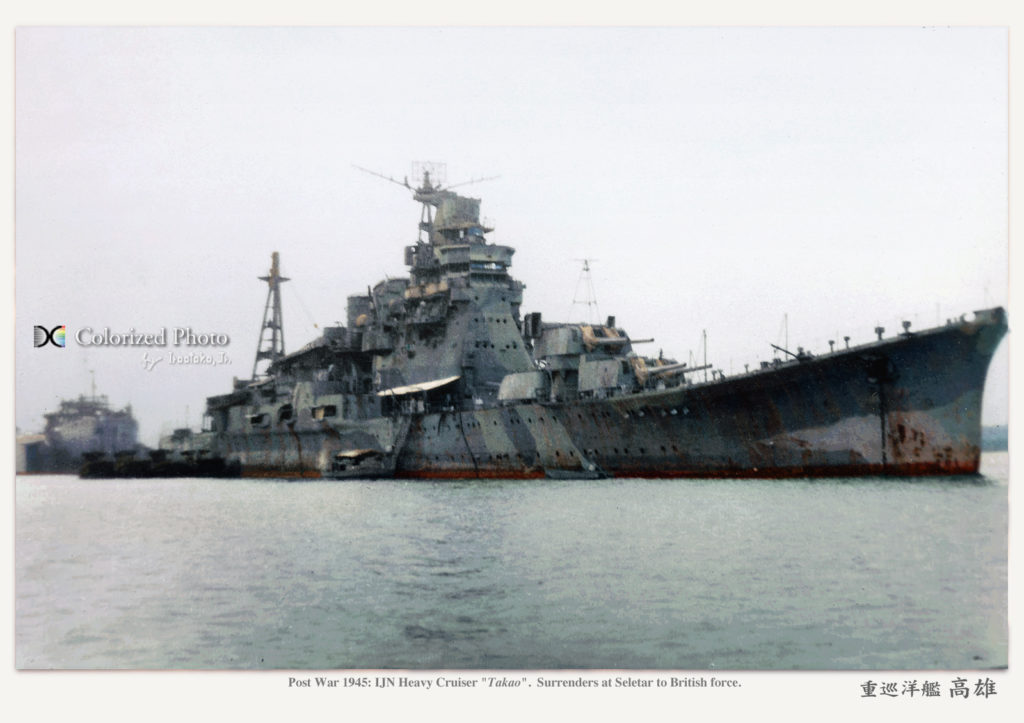
Takao surrendering to British Forces in 1945
IJN Atago
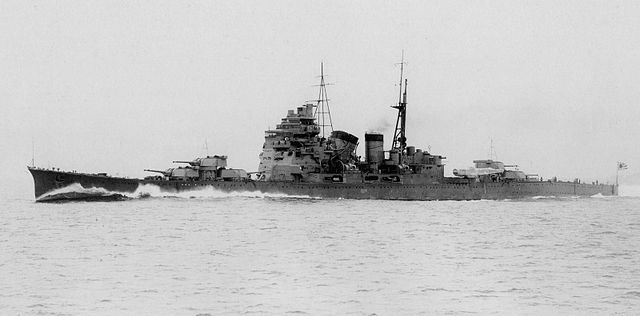
Sea trials, 1932
IJN Atago was laid down at Kure in April 1927, launched on 16 June 1930, commissioned on 30 March 1932 and attached to the Yokosuka Naval District, Sentai-4, 2nd Fleet. All four “mountains” trained together for years. On 14 May 1932, Prime Minister Inukai Tsuyoshi was a guest onboard Atago. He was assassinated a day after. On 26-28 May, Atago also hosted Emperor Hirohito, for a short cruise from Kobe to Etajima and back before standing at the naval review in Kobe. By that time her first captain was Ibō Takahashi (December 1932-November 1933) followed by Seiichi Itō from April (until 1 December 1936) and Aritomo Gotō until 12 July 1937.
Like her sister ship she shown acute stability issues and mediocre seaworthiness. Atago was rebuilt from 1938 like her sister ship? Afterwards she patrolled off the coast of China in 1940-1941, with Captain Tomiji Koyanagi in command until July 1941 and later Matsuji Ijuin. On 29 November she became the flagship of Vice Admiral Nobutake Kondō’s Sentai-4, ready for operations in the Pacific.
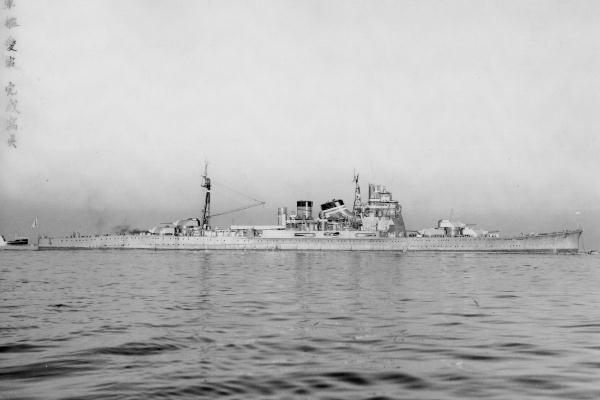
Post-refit trials, 1939
Early Operations
On 7 December, she was off Mako Guard District, Pescadores Islands, supporting the invasion of Malaya and of thr Philippines. Until March 1942 she was based out of Palau, and participated in the Netherlands East Indies camoaign, taking part in the Battle of the Java Sea. On 2 March she sank USS Pillsbury and later attacked a Dutch convoy from Tjilatjap, bound for Fremantle, duelling with HMAS Yarra, sinking freighters and capturing the 1030 ton Dutch vessel Duymaer van Twist and the 7089 ton freighter Tjisaroea, later pressed into Japanese service. She returned for a maintenance at Yokosuka Naval District on 17 April 1942, and later rushed to catch it but without success, Admiral Halsey’s TG 16.2 after the Doolittle Raid. Her second modernization took place at Yokosuka between 22 April and 21 May 1942. Her AA artillery was modified and radar installed. She departed for the Battle of Midway, but used to escort transports ferrying invasion troops., which will never took place.
Guadalcanal campaign
On 11 August 1942, Atago departed Hashirajima with her unit, Sentai-4, still her flagship and the 2nd Fleet for Truk. “Operation Ka” was planned, a major reinforcement of Guadalcanal. She took part in Battle of the Eastern Solomons, and two of her Aichi E13A1 “Jake” floatplanes were short down by USS Wasp’s aviation. She only saw from afar the Battle of Santa Cruz Islands on 26–27 October 1942. She however took part in the second Naval Battle of Guadalcanal on 15 November, duelling with USS South Dakota and Washington, and launched eight Type 93 “Long Lance” torpedoes at USS Washington, missing. Damaged slightly she returned to Kure for repairs. On 25 January 1943, Atago was back in Truk but only to cover the evacuation of Guadalcanal. She remained in Truk until July 1943, back to Yokosuka for maintenance, modernization and refit, receiving new triple 25 mm (0.98 in) AA guns.
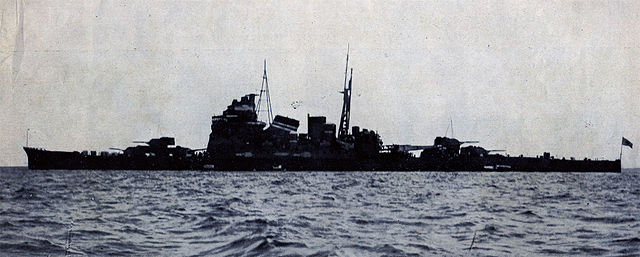
On 23 August 1943 she was back to Truk, escorting troopships to Rabaul and other sorties in the the Solomon Islands until November 1943. Following the Gilbert Islands raid, IJN Atago as part of Ozawa’s fleet made an unsuccessful sortie, missing the US Force entirely. After the Allied landings on Bougainville (1 November 1943), she headed for Rabaul to prepare the attack, but the base was raided on 5 November, by 97 planes from USS Saratoga and Princeton. Atago saw three near-misses, killin 22 as well as Captain Nakaoka because of bomb splinter. On 15 November, she returned to Yokosuka for repairs, while a Type 22 surface-search radar set and more AA were fitted. In January 1944, she was back to Truk and on 10 February, while underwya she was ambushed by USS Permit at night, missing. Back to Sentai-4 (Palau, Ozawa’s First Mobile Fleet) from 1st March, and then Davao (southern Philippines), 1 April, she made anoyther sortie, once again targeted, this time by USS Dace on 6 April.
On 13 June, she took part in the Battle of the Philippine Sea in Kurita’s Mobile Force Vanguard from Tawi Tawi, trying to lure out US Forces off Saipan. The “Great Marianas Turkey Shoot” followed and Kurita atacked Task Force 58 off of Saipan with success. Atago was back at Hashirajima on 24 June a new maintenance, also receiving a Type 13 air-search radar and more Type 96 AA guns. This was her last trip back to Japan.
Battle of Leyte Gulf
In July-October 1944, IJn Atago took back her position as flagship of Vice Admiral Kurita’s First Mobile Striking Force, by then concentrating all what remained of the IJN surface battle fleet. it was at Lingga Roads near Singapore, close to fuel depots. Kurita sortied on 22 October to Leyte Gulf, Atago as flagship of the “Center Force”, Sentai-4. While underway she was ambushed by USS Darter and Dace in the Palawan Passage. Atago took four torpedo hits. Crippled, ablaze, she capsized at 05:53 and went under 1,800 m (5,900 ft) of water, with 529 survivors, including Vice Admiral Kurita, Rear Admiral Tomiji Koyanagi and Rear Admiral Araki. The rest of the crew, and her captain went down. She was stricken on 20 December 1944.
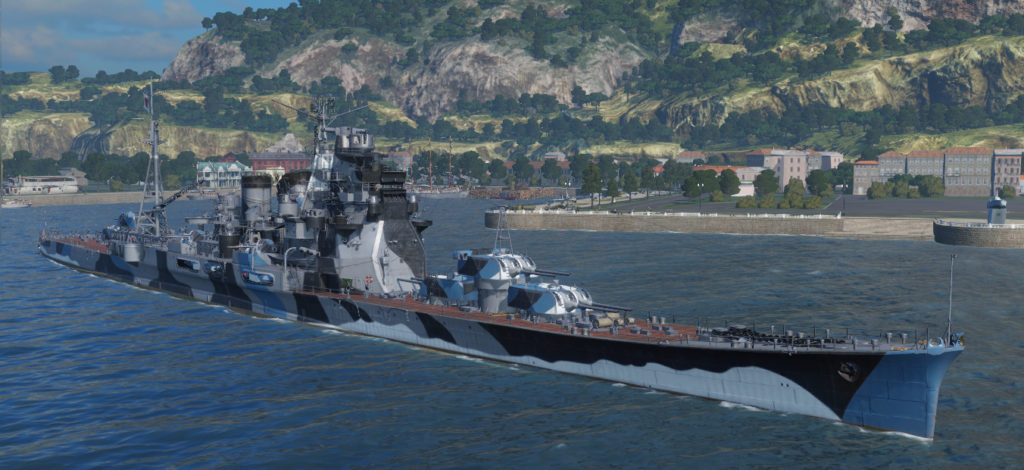

WoW’s hazardous renditions of the IJN Atago
IJN Maya
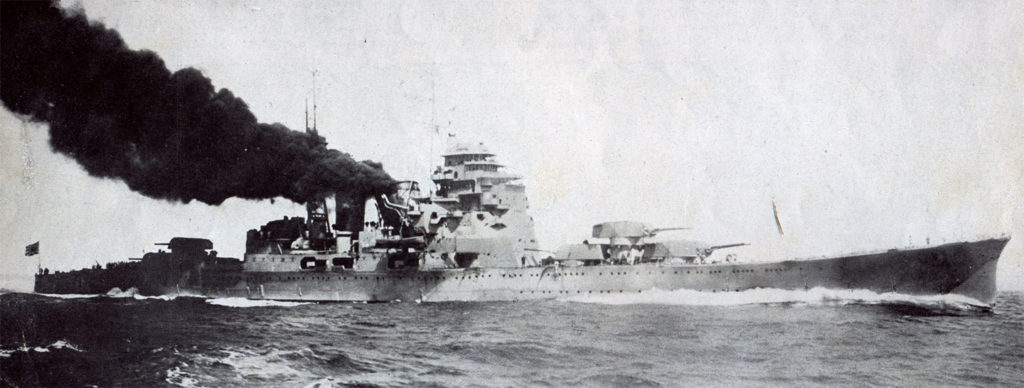
IJN Maya in 1932 sea trials, smoking generously
IJn Maya was laid down at the Kawasaki Shipyards (Kobe) on 4 December 1928, launched 8 November 1930, commissioned on 30 June 1932, assigned to the Yokosuka Naval District, Sentai-4, 2nd Fleet, training intensively. Her first captain was Masaichi Niimi (15 November 1932), then Jisaburō Ozawa (until 28 October 1935) reporting her stability, seaworthiness issues, but she was not overhauled. Instead she covered the IJA’s 6th Division in China in August 1937. At the start of the Pacific War, her unit was in the Pescadores Islands. The followed the northern Philippines campaign, Lingayen gulf (part of Vice Admiral Ibō Takahashi’s 3rd Fleet with Ashigara and Kuma) escort for the third Malaya Convoy, Natuna islands landngs, Palau patroled and southern Philippines campaign. From February 1942 she covered the Darwin raid. Based in Staring-baai in the Celebes she took part in the hunt for the escaping Dutch East Indies forces to Australia. On 2 March her floatplanes spotted HMS Stronghold later sank by others. She also sank USS Pillsbury and later the gunboat Asheville south of Java. On 4 March she attacked the convoy from Tjilatjap; She was drydocked at Yokosuka Naval Arsenal (more AA guns installed, abreast the forward funnel).
In April 1942, she missed Halsey’s TF 16.2 after the Doolittle Raid. In June 1942, with Takao she took part in the Aleutian Islands campaign. In August 1942 she participated “Operation Ka”. On 15 October she shelled Henderson Field (Guadalcanal) and later participated in the the Battle of the Santa Cruz Islands’s night combat. On 3 November she was sent with Chikuma (8th Fleet) at Shortland Island for another run on Henderson Field. She was albushed on her way back by USS Flying Fish but missed. VB-10 (USS Enterprise dropped) Dauntless later attacked her, and she took a near miss 500-pound (227 kg) astern. Her mainmast was damaged as the downed SBD crashed into her port side, putting her 4.7-inch shells ablaza, killing 37. She was back to Yokosuka for repairs and refit in January 1943.
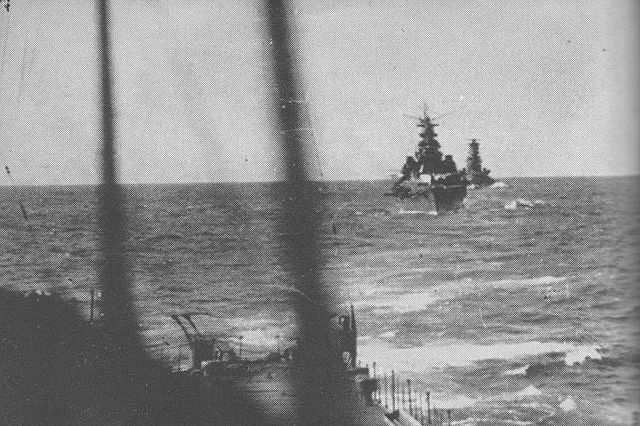
She then took part in the evacuation of the Kurile Islands and on 26 March (Vice Admiral Hosogaya’s IJN Fifth Fleet), the Battle of the Komandorski Islands (Kamchatka) with USS Richmond and Salt Lake City, Rear Admiral Charles H. McMorris’ TG 16.6. Maya launched Type 93 “Long Lance” torpedoes but missed. She was lightly damaged by gunfire. Repaired in Yokosuka, she was back there late April, and became flagship of the IJN Fifth Fleet, evacuating Kiska in August. After another refit in Yokosuka, she joined Chōkai to Truk, ferrying troops afterwards between Truk and Rabaul. On 5 November, she was attacked by SBD Dauntless from USS Saratoga in Rabaul. She took a bomb hit on her deck portside, above the No. 3 engine room. The fire raged and she lost 70 crewmen. Summarily repaired at Rabaul, she was back at Yokosuka, repaired and refitted as an anti-aircraft cruiser. Her No.3 turret and aircraft hangar were removed, and thirteen triple mount, nine single mount Type 96 AA guns, six twin-mount 127-mm guns, 36 Type 93 machine guns installed, quadruple TTs installed, Type 22 surface-search radar also. This was over 9 April.
From April to June 1944, IJN Maya took part in the defense of the Philippines, and the Battle of the Philippine Sea, damaged by near-misses. Her planes spotted Task Force 58 at 300 miles and she went into a ring formation with Kongō, Haruna, and the escort to protect IJN Chiyoda, later attacked by over 50 TBF Avenger torpedo bombers from USS Bunker Hill, Monterey, and Cabot. On 20 June, she was back in Yokosuka and embarked more Type 96 single-mount AA guns. On 14 July, she carried the 28th Division to Miyako-jima and hered for Singapore, then Brunei on 20 October.
Two days later she was in the Battle of Leyte Gulf (Sentai-5 with her sister ships) and on 23 October, were ambushed in the Palawan Passage. Atago received four torpedo hits from Darter and sank in around 18 minutes, with 336 officers and men, while 769 were rescued.
IJN Chōkai
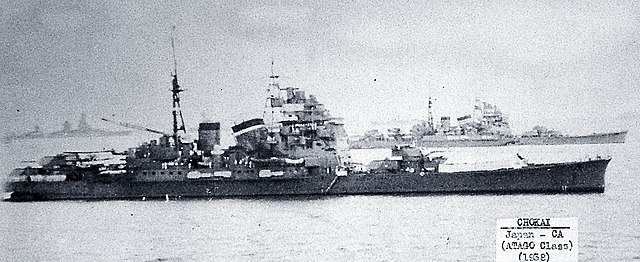
IJN Chokai, ONI
IJN Chokai was started on 26 March 1928 at Mistubishi shipyards, launched on 5 April 1931, and commissioned on 30 June 1932. Like Maya, she was in Sentai 4, 2nd fleet, training intensively with her other two sister ships. Her stability problems were detected but like Maya she was not rebuilt. Instead she covered operations in China in 1937-1941, alternativing with patrol cruusers and training. At the start of the Pacific War, she took part in the invasion of Malaya and tracked Force Z. In January-February 1942, she took part in the Dutch East Indies and Borneo campaigns. However she strucke a reef off Cape St. Jacques on 22 February 1942 and went to Singapore for repairs. Afterwards she covered the landings at Iri, Sumatra, and Andaman Islands, Port Blair, then Mergui, in Burma. On 1 April 1942, this was Operation C targeting the merchant shipping in the Indian Ocean. She sank the US freighter Bienville, and British Ganges on 6 April, then back to Yokosuka on 22 April 1942.
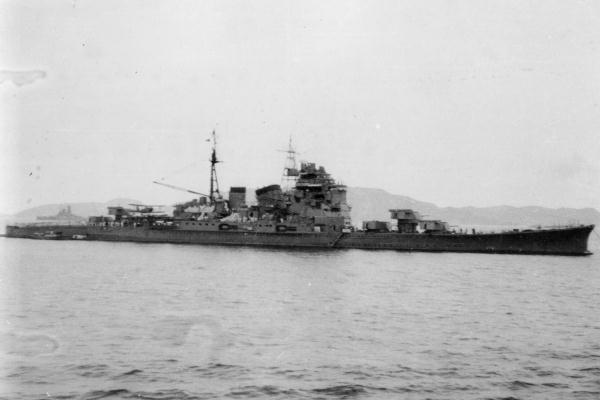
Chokai 1942, Chuuk islands
The Guadalcanal campaign
By mid-July 1942, Chōkai became flagship of Vice Admiral Mikawa Gunichi, 8 Fleet, in Rabaul. On 7 August 1942, she took part in the battle of Savo Island (Mikawa’s squadron) helping sinking four allied cruisers, and badly damaging other ships. She was however hit by Quincy and Astoria. Her “A” turret was destroyed (34 KiA) and she was repaired back in Rabaul, later participating in night battles, only taking light damage in action. She was detached from the 8th Fleet as a flagship after the evacuation of Guadalcanal, and was repaired an dmodernized at Yokosuka on 20 February 1943. She was relatively inactiove until the first half of 1944, when she became the flagship of the Cruiser Division Four with her sister ships on 3 August 1944. She took part in the battle of Philippine Sea, but left undamaged.

Leyte Gulf
At the Battle of Leyte Gulf Chōkai took part in the various engagements until the sub attack of 23 October 1944. Maya and Atago when down, Takao was crippled, but Chōkai escaped. Her division no longer existed. She joined Cruiser Division Five, and survived an air attack on 24 October 1944, (IJN Musashi was sunk that day). She was the only cruiser of her class to participate in the epic
battle off Samar, on 25 October, engaging Taffy 3 in an apparently hopeless fight. But instead she was hit several times on the port side amidships by main destroyer caliber guns, one apparently setting on fire her deck-mounted Japanese Type 93 “Long Lance” torpedoes, although RV Petrel’s expedition in 2019 proved it otherwise. In any case she suffered a terrble explosion while soon after a TBM Avenger (from Kitkun Bay) lodged a 500 lb (230 kg) bomb in her forward machinery room. Dead in the water she was evacuated and scuttled later by IJN Fujinami, which later sank with most rescued crew from Chokai.
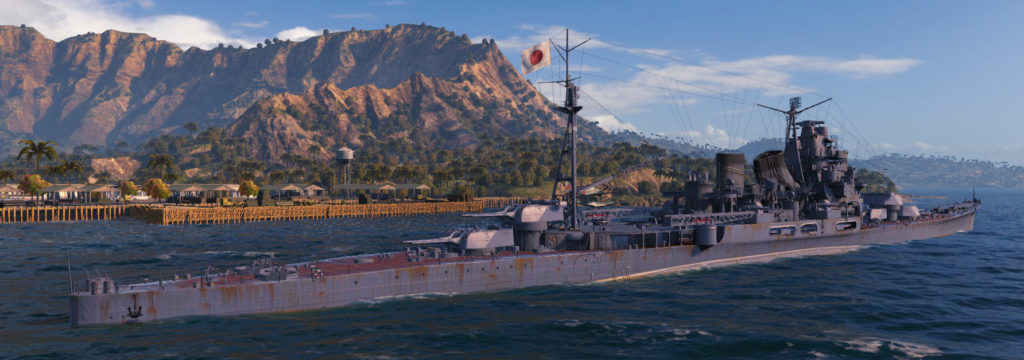
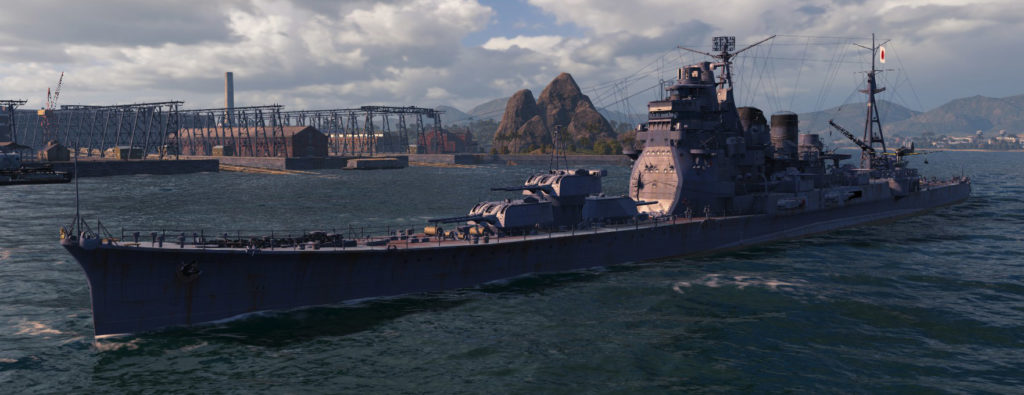

Wow’s renditions of IJN Chokai
Video: IJN Chōkai’s wreck explored by M/V Petrel

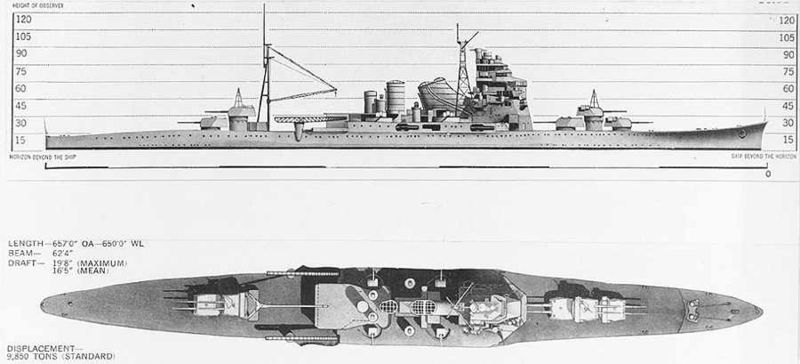
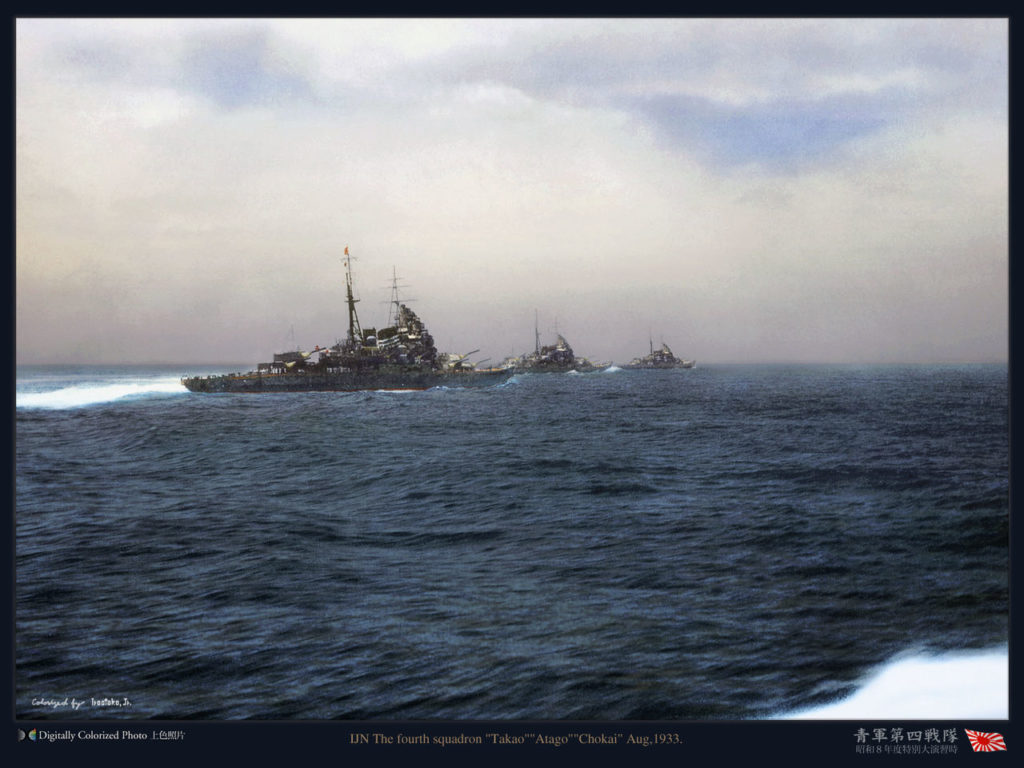
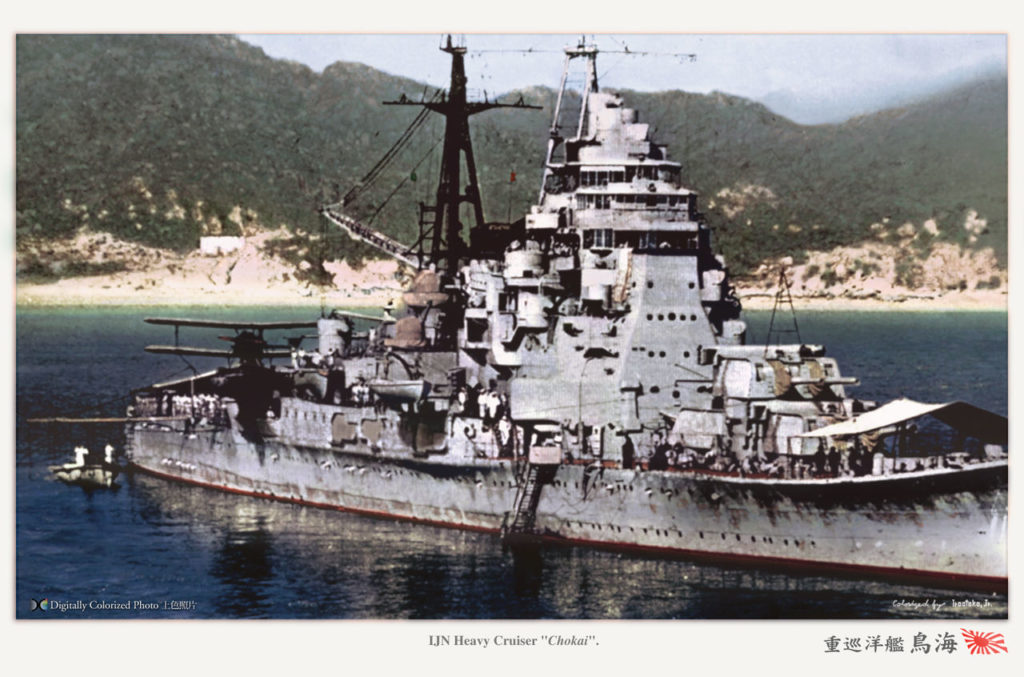
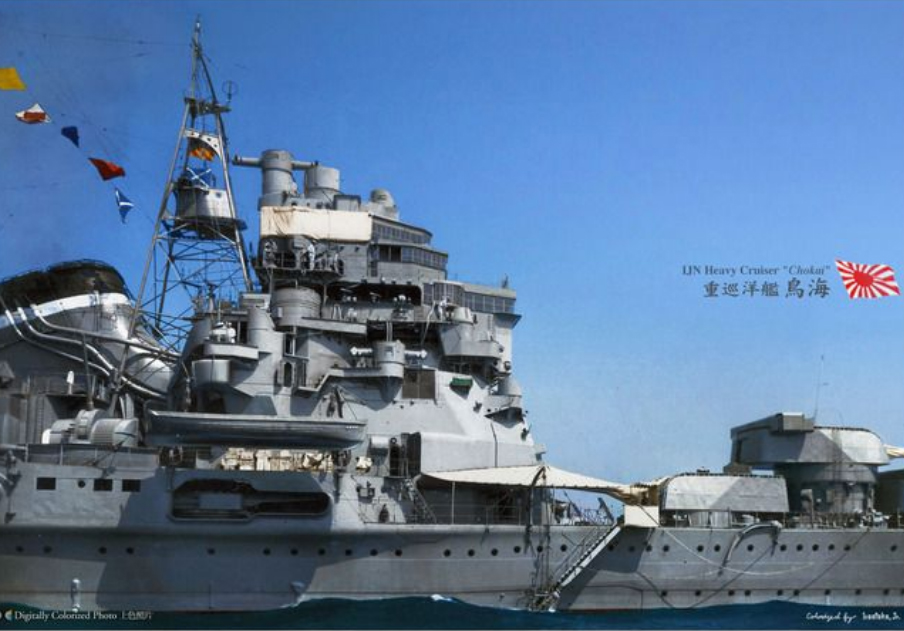
 Latest Facebook Entry -
Latest Facebook Entry -  X(Tweeter) Naval Encyclopedia's deck archive
X(Tweeter) Naval Encyclopedia's deck archive Instagram (@navalencyc)
Instagram (@navalencyc)





 French Navy
French Navy Royal Navy
Royal Navy Russian Navy
Russian Navy Armada Espanola
Armada Espanola Austrian Navy
Austrian Navy K.u.K. Kriegsmarine
K.u.K. Kriegsmarine Dansk Marine
Dansk Marine Nautiko Hellenon
Nautiko Hellenon Koninklije Marine 1870
Koninklije Marine 1870 Marinha do Brasil
Marinha do Brasil Osmanlı Donanması
Osmanlı Donanması Marina Do Peru
Marina Do Peru Marinha do Portugal
Marinha do Portugal Regia Marina 1870
Regia Marina 1870 Nihhon Kaigun 1870
Nihhon Kaigun 1870 Preußische Marine 1870
Preußische Marine 1870 Russkiy Flot 1870
Russkiy Flot 1870 Svenska marinen
Svenska marinen Søværnet
Søværnet Union Navy
Union Navy Confederate Navy
Confederate Navy Armada de Argentina
Armada de Argentina Imperial Chinese Navy
Imperial Chinese Navy Marinha do Portugal
Marinha do Portugal Mexico
Mexico Kaiserliche Marine
Kaiserliche Marine 1898 US Navy
1898 US Navy Sovietskiy Flot
Sovietskiy Flot Royal Canadian Navy
Royal Canadian Navy Royal Australian Navy
Royal Australian Navy RNZN Fleet
RNZN Fleet Chinese Navy 1937
Chinese Navy 1937 Kriegsmarine
Kriegsmarine Chilean Navy
Chilean Navy Danish Navy
Danish Navy Finnish Navy
Finnish Navy Hellenic Navy
Hellenic Navy Polish Navy
Polish Navy Romanian Navy
Romanian Navy Turkish Navy
Turkish Navy Royal Yugoslav Navy
Royal Yugoslav Navy Royal Thai Navy
Royal Thai Navy Minor Navies
Minor Navies Albania
Albania Austria
Austria Belgium
Belgium Columbia
Columbia Costa Rica
Costa Rica Cuba
Cuba Czechoslovakia
Czechoslovakia Dominican Republic
Dominican Republic Haiti
Haiti Hungary
Hungary Honduras
Honduras Estonia
Estonia Iceland
Iceland Eire
Eire Equador
Equador Iran
Iran Iraq
Iraq Latvia
Latvia Liberia
Liberia Lithuania
Lithuania Mandchukuo
Mandchukuo Morocco
Morocco Nicaragua
Nicaragua Persia
Persia San Salvador
San Salvador Sarawak
Sarawak Uruguay
Uruguay Venezuela
Venezuela Zanzibar
Zanzibar Warsaw Pact Navies
Warsaw Pact Navies Bulgaria
Bulgaria Hungary
Hungary

 Bundesmarine
Bundesmarine Dutch Navy
Dutch Navy Hellenic Navy
Hellenic Navy Marina Militare
Marina Militare Yugoslav Navy
Yugoslav Navy Chinese Navy
Chinese Navy Indian Navy
Indian Navy Indonesian Navy
Indonesian Navy JMSDF
JMSDF North Korean Navy
North Korean Navy Pakistani Navy
Pakistani Navy Philippines Navy
Philippines Navy ROKN
ROKN Rep. of Singapore Navy
Rep. of Singapore Navy Taiwanese Navy
Taiwanese Navy IDF Navy
IDF Navy Saudi Navy
Saudi Navy Royal New Zealand Navy
Royal New Zealand Navy Egyptian Navy
Egyptian Navy South African Navy
South African Navy






























 Ukrainian Navy
Ukrainian Navy dbodesign
dbodesign
Chokai was crippled after receiving 18 to 20 bombs from the bombers of the carrier Kitkun Bay, remained afloat but lost direction and strength as seen. Seen from the crew of the heavy cruiser Tone, shortly after the battle, Captain Tatsuji Matsuzaki aboard the destroyer Fujinami, was responsible for the scuttle at 10 am, ironically, he said that Chokai was scuttled at 10:40 pm.
It is worth remembering that Chokai was highly effective in sinking the heavy cruisers Canberra, Viscennes, Astoria and Quincy and damaging Ralph Talbot, Patterson and Chicago during the battle of Savo Island. Their crew was considered an Elite before they became fatigued and discouraged after the Marianas Turkey Shoot.
The armament of the Takao class was considered very good by the Japanese, the dispersion discrepancies were caused by the powder bag much more energetic than that of other nations, in the overall the accuracy was better than the 8″/55 Mark 9 USN weapon that had a dispersion of 1830 meters over a distance of 19,300 meters, remembering that the Japanese 20.3cm / 50 had a tighter spread, from 330 to 483 meters at a distance of 19,300 and 22,000 meters.
After improvements in 1938, they now have a dispersion of 280 meters over a distance of 22,000 meters. The impact power compared to other nations’ weapons was also superb, the Type 91 shell according to USN had excellent penetration characteristics, in the same test they were identical with the shell of the German gun of 20.3cm/60 of 122kg.
An interesting point about the Takao class that unfortunately nobody says, is that by far they had superior stability compared to the Mogami class, as well as the hull using longitudinal rivets that increased the resistance more, Chokai was considered superb, because it was made by Mitsubishi, its internal part was more powerful and luxurious.
In general, the Takao class and the New Orleans class had a very similar defect, the weight of the superstructure, although the Takao metacentric height was 1.50m and New Orleans 1.52m, Wichita 1.40m, Kent 1,37m.
Chokai, Maya as well as Wichita were quite heavy, but in their entire career this did not put them at risk.
~Brazil